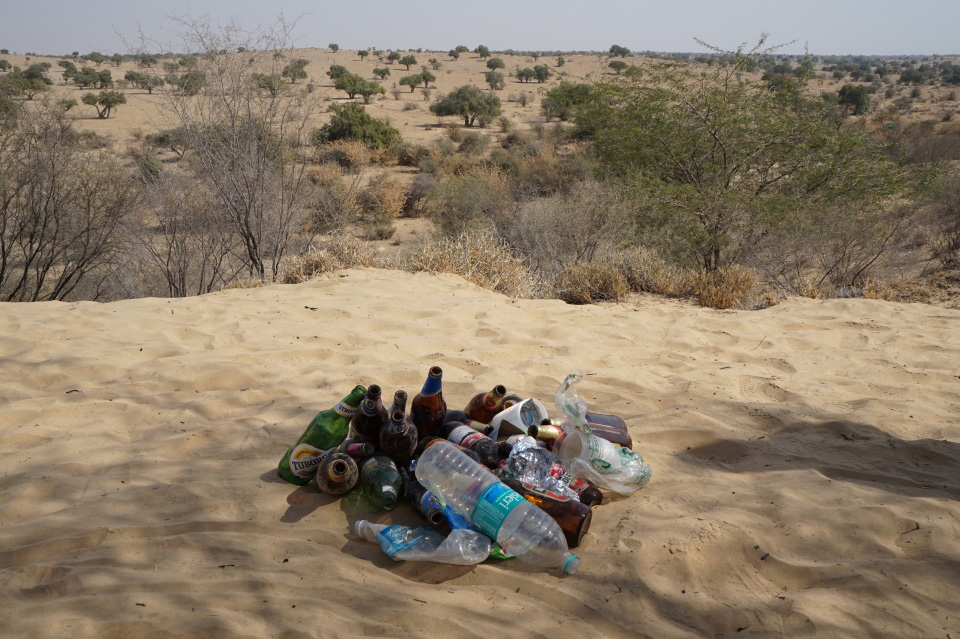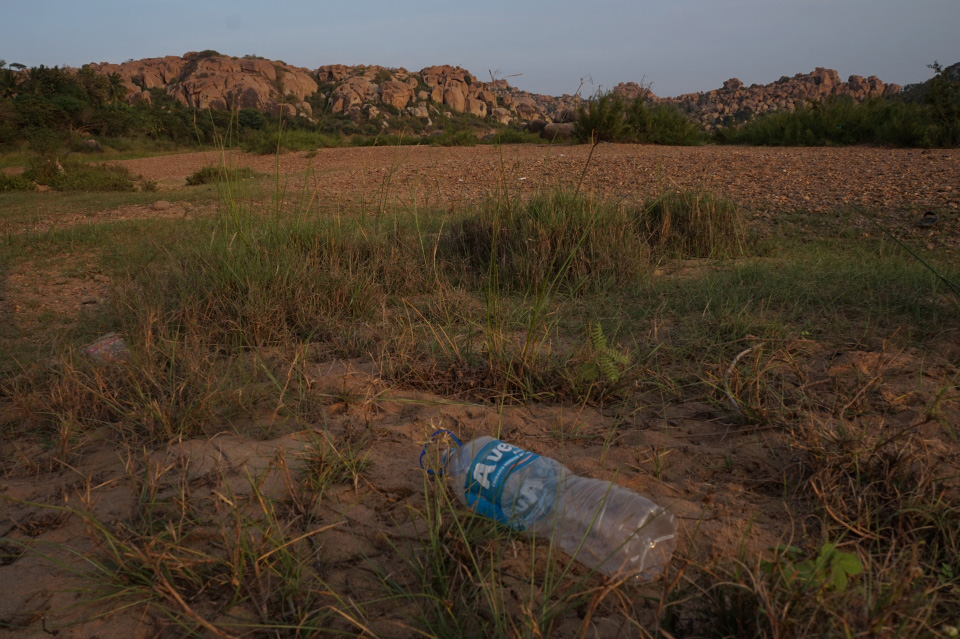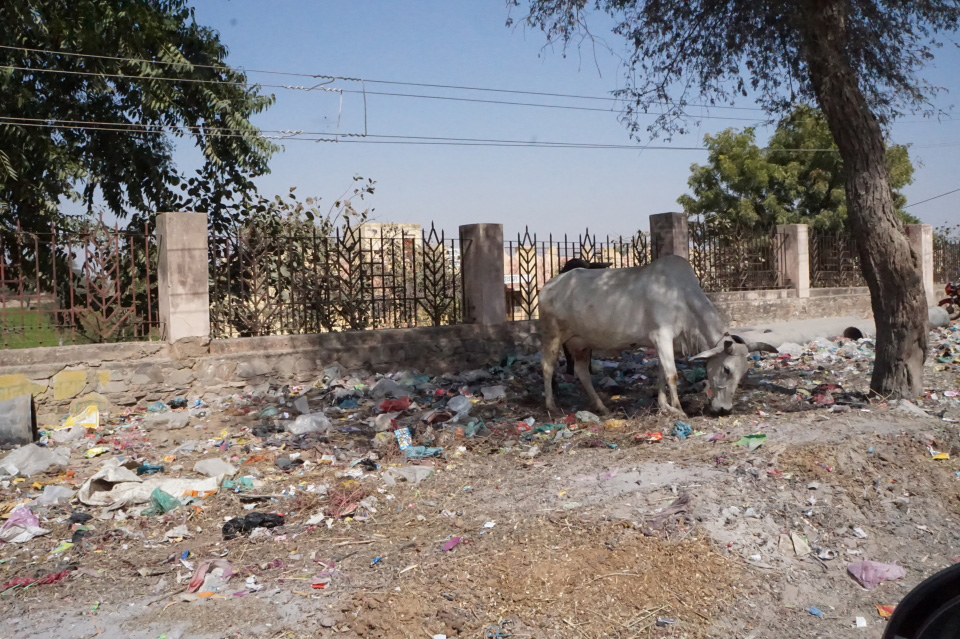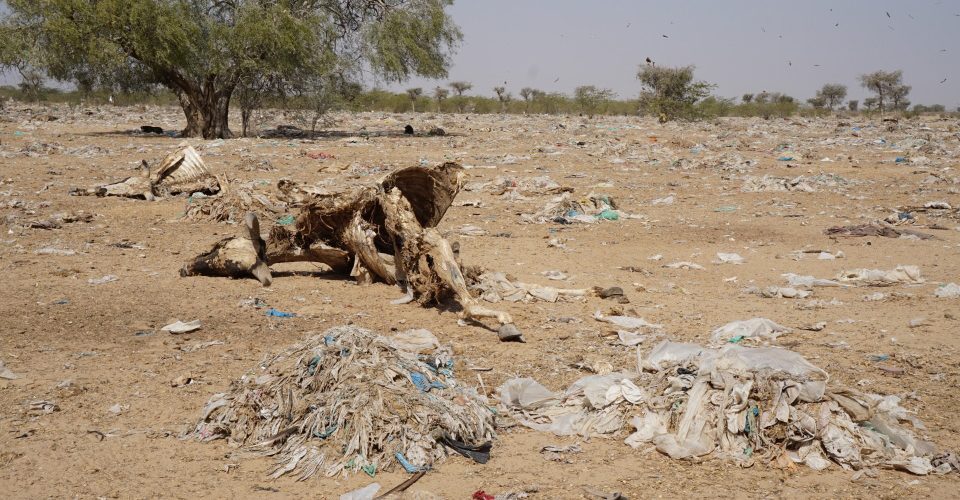“Do you see those mounds of plastic?” our guide asks. “Each one was a cow.”
Jitu Solanki is a wildlife expert working on his PhD in Zoology. He also leads wildlife tours from the guesthouse in Bikaner, Rajasthan (India’s largest state), with his wife, Puja. He can always guarantee you will see a couple hundred Egyptian vultures, eagles and griffons on his tour, because the tour includes the fields where dead cows are brought by Untouchables to be stripped of their hides, the meat picked clean by dogs and birds, and the dry bones ground up and sold. What’s left at the end is the plastic from the stomach of each cow, and a field of plastic mounds. It’s the eternal cycle of life, with the addition of a new element that does not break down.
India is awash in plastic. It is a recent phenomenon – we’ve been told that the cultural shift to widespread use of plastic bags and bottles here is little more than a decade old. This is a society that has always thrown its waste onto the curbside where it either is eaten by stray dogs, goats and cows; degrades over time; or is collected into piles and burned. Introduce plastic into a centuries-old practice, and you have a recipe for ecological disaster.
RELATED: Waste Mismanagement Leads to Plastic-Filled Oceans – India is the 12th highest contributor.
As Westerners, we are shocked by the litter, but even the most environmentally aware Indians seem resigned to the inevitability of it. Jitu parks his jeep at a favourite vantage point looking out over the desert land that is protected by local Bishnoi people who have a strong spiritual connection with the land and desert species. As we look around, we see a dozen empty beer bottles and spend fifteen minutes collecting a pile to take home. It is a small and futile gesture.

A collection of litter in the desert outside Bikaner.
This sense of futility is commonplace. From the camel driver on our overnight safari into a bottle-strewn desert in Rajasthan, to the guide in the Ayurvedic spice preserve and the ranger at the Periyar Tiger Reserve in the southern state of Kerala – people who you would expect to have a stronger sensitivity to the impact of litter – there is a resigned acceptance to the fact that India simply has a culture of litter.
The irony is that Indians are exceedingly conscious of cleanliness and beauty in their personal space. Across rural India, we have seen women wearing the most exquisite saris, and even the simplest of homes are swept daily and kept scrupulously clean. It’s only once you move beyond the boundaries of the home into the commons that the behaviour changes. Personal space is pristine, but the streets are an ecosystem of animals and garbage, and plastic has no place in an ecosystem.
Solving the garbage and plastic problem is a microcosm of the cultural, economic, and environmental problems facing India as it grapples with a growing population and the integration of a western-influenced economy and lifestyle. Plastic pollution may be a global problem, but India is particularly ill-prepared to deal with the responsibilities and consequences.
The Indian government has recognized litter and plastic as a national problem. Plastic bags have been banned in many regions, but a trip to any local market or store will show that it is not effective. A national sanitation campaign, Swachh Bharat (“Clean India Campaign”), has set goals for improving sanitation facilities but also focuses on cleaning streets. It is a “snowball” campaign started by Prime Minister Modi, who challenged nine celebrities to join the campaign and each challenge nine others in turn.
The streets are an ecosystem of animals and garbage, and plastic has no place in an ecosystem.
Swachh Bharat is meeting with some success, but the behaviours run deep and the campaign is facing pushback from people who feel it is a government responsibility to clean the streets with tax money.
Compare with Canada, and Ontario in particular. In the early 1980s, the pop companies wanted to introduce plastic bottles into a market that was dominated by reusable glass bottles. The eventual compromise solution was to place a quota on glass bottles and to establish a shared-cost model between industry and government to develop recycling facilities and programs. The quota was never met and was eventually dropped, but the shared-cost model has grown into full-scale recycling programs across Canada. The end result is that Canada is also awash in single-use plastic bags and bottles, but it has the infrastructure to collect and recycle all the empties (though diversion rates are still not optimal).
In India, there is no deposit or recycling charge levied on bottles or bags, and the Indian plastics industry is gleefully predicting a doubling of demand for plastics by 2020. A 2014 article on the website of ExoPackaging, an Indian plastics firm, points to the growth potential in India, where the annual per capita consumption is only eight kilograms, compared with 60 kg in developed countries. At a time when corporate leadership is drastically needed, very little acknowledgement and commitment is being given by the major bottlers about the need to collect and recycle their containers.

An empty water bottle on a field in Hampi.
Swachh Bharat is an effort to change Indian habits, but it overlooks an obvious option: put a price on plastic. Even a single rupee on plastic bags and a five-rupee deposit on plastic bottles would shift the demand overnight and create an incentive to collect all the old bags and bottles. But while this may be an obvious solution, it would meet with strong opposition from people and the major bottlers alike, just as it did initially in Canada.
Cows live side-by-side with humans in India, wandering freely and placidly on every urban and rural road and even the new four-lane divided highways. Cows rule the road, moving from place to place searching for scraps to eat. Now that nearly every roadside in India is covered in plastic, it is no surprise to find that these sacred animals are suffering and dying from stomachs full of plastic.

A cow forages amongst the plastic in Jaipur.
It may seem unfathomable to us that Indians are blind to the problem, but then we need to remember that our culture is equally blind and incapable of dealing with our obvious smog and pollution resulting from our overconsumption of oil and resources. The real message here is to understand how difficult it can be to change deeply entrenched attitudes and behaviours.
If the simple solution in India is to put a price on plastic, then who are we to argue against a price on carbon?
The former executive director of the Conservation Council of Ontario, Chris has started a new initiative to help Canada transition to a sustainable future by “living better with less,” Canada Conserves. After 30 years in the environmental movement, Chris Winter is on a well-deserved round-the-world sabbatical with his family. Along the way, Chris will be sharing examples of how other countries are dealing with climate change, resource scarcity and economic turmoil. Follow him on Twitter or Facebook. You can also follow the family’s Hello Cool World tour blog.













